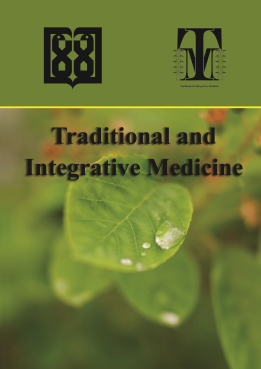Frequency of Chief Complaints in Patients Referring to Persian Medicine Clinics
Abstract
Today, for various reasons, there is a growing tendency towards traditional and complementary medicine in the world as well as growing interest in Persian Medicine in Iran. This study aimed to investigate the frequency of major complaints by patients in some chosen Persian Medicine clinics. In this retrospective cross-sectional study, 1319 files of patients referred to Persian Medicine clinics of Tehran University of Medical Sciences in the fourth week of each month in 2012 were investigated and analyzed in terms of major complaints and demographic indices. Data gathering tool was an information form regulated based on main study goals. Data were analyzed by SPSS software Version 19. mean age of patients was 40.82 ± 16.006 years. The most common complaint in all the clinics was musculoskeletal problems (28,7%). Most of the patients were single housewives (38%). The most common complaints in the single-patient group were musculoskeletal problems (35.44%) and in the married-patient group were skin problems (29.41%). The most common complaints in both genders were musculoskeletal complaints (26% in men &31.44% in women). Due to the prevalence of women referral to Persian Medicine centers, adequate knowledge of gynecological diseases is one of the requirements of Persian Medicine professionals that should be considered in their education. Planning for adequate knowledge of musculoskeletal, digestive, and skin diseases should also be considered in educational curricula.
World Health Organization. General guidelines for methodologies on research and evaluation of traditional medicine. Geneva: World Health Organization. 2000.
World Health Organization. The Promotion and Development of Traditional Medicine. Report of a WHO Meeting. WHO series.Geneva1978 (No. 622); pp 8-13, 36-39.
Qi Z. WHO Traditional Medicine Strategy. World Health Organization.Geneva 2013; pp 2014-2023.
Gordon JS. The White House Commission on complementary and alternative medicine policy and the future of healthcare. AlternTher Health Med2004;1:10-20.
Alizadeh M. Movement of western communities from Complementary Medicine to Integrative Medicine. Darmangar2004;1:14-17.
Shahabi S, Hassan ZM, Mahdavi M, Dezfouli M, Rahvar MT, Naseri M, Jazani NH, Khalkhali HR. Hot and cold natures and some parameters of neuroendocrine and immune systems in traditional Iranian medicine: a preliminary study. J Altern Complement Med 2008;14:147-156.
Peltzer K, Pengpid S. Prevalence and determinants of traditional, complementary and alternative medicine provider use among adults from 32 countries. Chin J Integr Med2018;24:584-590.
Mahmoudian A, Golshiri P, Rezaei G, Akbari M. Patients' satisfaction form iraniantraditional medicine. Journal of Isfahan Medical School 2012;30:1550-1558.
Maghsoodi S, Tavakolian F. Factors influencing patients’ satisfaction with traditional medicine in kerman city in 1393. jiitm2015;6:241-248.
Dashtibidskan MR. Frequency of application of complementary medicine methods in patients referred to the internal medicine clinic of Vali-e-Asr Hospital of Birjand in the second half of the year 92. [Doctorate Thesis]. Medical School of Birjand University of Medical Sciences,Iran; 2013.
Seddighi J, Maftoon F, Moshrefi M.Complemetary medicine: Knowledge, attitude and practice in Tehran. Payesh2004;3:279-289.
Yargholi A, Zareian MA, Hafizi S, Faryabi R, Tabarraei M. Review on invasive and semi-invasive procedures to treat abnormal uterine bleeding in Iranian traditional medicine. IJOGI2017;20:46-55.
Tehrani Banihashemi SA, Asgharifard H, Haghdoost AA, Barghmadi M, Mohammadhosseini N. The use of complementary/alternative medicine among the general population in Tehran, Iran. Payesh2008;7:355-362.
Frass M, Strassl RP, Friehs H, Müllner M, Kundi M, Kaye AD. Use and acceptance of complementary and alternative medicine among the general population and medical personnel: a systematic review. Ochsner J 2012;12:45-56.
Kemppainen LM, Kemppainen TT, Reippainen JA, Salmenniemi ST, Vuolanto PH. Use of complementary and alternative medicine in Europe: Health-related and sociodemographic determinants. Scand J public health 2018;46:448-455.
Schwarz S, Messerschmidt H, Völzke H, Hoffmann W, Lucht M, Dören M. Use of complementary medicinal therapies in West Pomerania: a population-based study. Climacteric 2008;11:124-134.
Skovgaard L, Nicolajsen PH, Pedersen E, Kant M, Fredrikson S, Verhoef M, Meyrowitsch D. Differences between users and non-users of complementary and alternative medicine among people with multiple sclerosis in Denmark: a comparison of descriptive characteristics. Scand J public health 2013;41:492-499.
Ernst E. Prevalence of use of complementary/alternative medicine: a systematic review. BullWorld health Organ 2000;78:258-266.
Shobeiri F, Jenabi E. The effects of vitamin E on muscular pain reduction in students affected by premenstrual syndrome. IJOGI 2014;17:1-5.
Ghaderi F, AsghariJafarabadi M, MohseniBandpei M. Prevalence of musculoskeletal pain and associated factors with low back pain during pregnancy. IJOGI 2013;15:9-16.
Akbari-Kamrani AA. Prevalence of complains and rehabilitation needs in 150 Patients. jrehab2001;2:46-50.
Mostafavi J, Pakdaman A. A comparison between traditional Iranian medicine and conventional medicine. Tehran University press. Tehran 1979.
| Files | ||
| Issue | Vol 5, No 1, 2020 | |
| Section | Research Article(s) | |
| DOI | https://doi.org/10.18502/tim.v5i1.2665 | |
| Keywords | ||
| Muscular pain; Women health; Iranian traditional medicine; Complementary medicine; Traditional medicine professionals | ||
| Rights and permissions | |

|
This work is licensed under a Creative Commons Attribution-NonCommercial 4.0 International License. |




